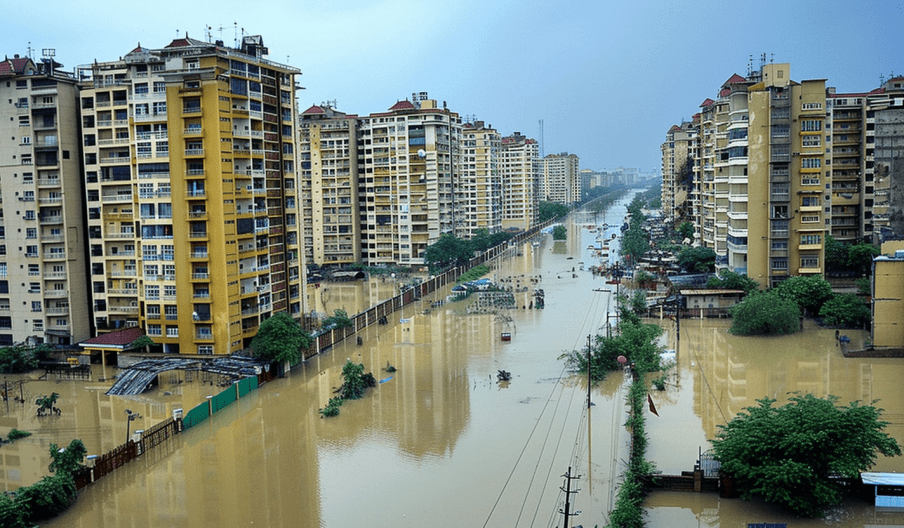- Kenya has faced a crisis brought on by heavy rains.
- The widespread damage caused by these rains has surpassed initial expectations, leaving communities struggling to cope.
- it’s paramount to prioritise properties in safer, flood-resistant areas for prime real estate opportunities.
- Going forward, It is imperative for stakeholders to prioritise preparedness and implement comprehensive measures to help mitigate any future occurrences.
In recent weeks, Kenya has faced a crisis brought on by heavy rains. Initially, many were hopeful when the rains began, especially after a prolonged dry spell. However, what started as light showers soon escalated into a serious situation. On August 22nd, 2023, the IGAD Climate Prediction and Applications Centre (ICPAC) warned of unusually wet conditions for October to December 2023, likening it to a strong El Niño event. While the predicted rains didn’t materialize at the time, they have since arrived with unexpected intensity, catching many Kenyans and the government off guard. The widespread damage caused by these rains has surpassed initial expectations, leaving communities struggling to cope.
Table of Contents
The impact of the rains for the Real Estate Sector?

As the Real Estate market in Kenya continues its upward trajectory, marked by significant investments in land, residential properties, and apartments, the recent onslaught of heavy rains has cast a shadow over the sector. What was once a promising avenue for investment has turned into a source of anguish for many Kenyans, as the deluge of rainwater swamps homes and leaves a trail of devastation in its wake. Heart-wrenching stories emerge, such as that of a homeowner grappling with the surreal sight of her house half-way submerged in water, a property for which she continues to diligently pay off her mortgage.
The uncertainty stemming from this situation has stirred widespread doubt, raising concerns about the durability of investments in light of natural disasters. Sadly, reports indicate that more than 40,000 Kenyans have already been forced from their homes, with plots of land submerged and their value diminished. Entire homes have been swept away, while others lie in ruins, rendering them uninhabitable.
Amidst this turmoil, Kenyans have not stayed silent. Renowned for their outspokenness, they have taken to online platforms to voice their perspectives with discussions ranging from critiques of the government’s response to proactive suggestions for addressing the crisis. In the midst of this dialogue, many Kenyans advocate for caution, emphasizing the importance of seizing the opportunity to reevaluate property investments. They highlight that with the current situation, it’s prudent to prioritise properties in safer, flood-resistant areas, suggesting that now is an opportune time to scout for prime real estate opportunities, given that it is easy to tell which ones are in flood-prone areas.
This sentiment is reflected in the shifting preferences of prospective buyers and tenants, who are increasingly cautious about properties situated in flood-prone zones. Consequently, there has been a noticeable decrease in demand for properties in these affected regions. Conversely, there is a surge in interest in properties located in elevated or less flood-prone areas, driving up demand and prices in these sought-after locales. These evolving trends underscore the profound impact of the floods on market dynamics and consumer behaviour within the real estate sector.
READ ALSO: Climate Change and Its Impact on Kenyan Real Estate
How to be Prepared for the Future.
Natural calamities such as floods can be quite unpredictable and as such, prioritizing preparedness is paramount. The current flood crisis has inflicted significant losses on investors and property owners, prompting urgent reflection on how to fortify resilience for future events. So, how can we enhance our readiness?

To better prepare the real estate sector for future floods and mitigate potential losses, several proactive measures can be implemented. Firstly, developers and urban planners should conduct thorough risk assessments to identify flood-prone areas and incorporate flood-resistant design features into new construction projects. This includes elevating buildings, implementing proper drainage systems, and utilising materials that are resilient to water damage.
Secondly, stricter building regulations and zoning laws should be enforced to restrict development in high-risk flood zones and ensure that existing structures meet stringent flood resilience standards. Additionally, investing in comprehensive flood mapping and early warning systems can provide timely alerts to property owners and residents, allowing them to take preventive measures and evacuate if necessary.
Moreover, promoting public awareness and education about flood risks and preparedness strategies is essential to empower individuals to make informed decisions about property investments and disaster response. By adopting a multi-faceted approach that combines infrastructure improvements, regulatory measures, and community engagement, the real estate sector can enhance its resilience to floods and minimise financial losses in the future.
READ ALSO: Check for Government Regulations/Zoning Issues
Conclusion
In conclusion, the recent floods in Kenya have underscored the vulnerability of the real estate sector to natural disasters and the urgent need for proactive measures to mitigate future risks. The devastation wrought by the floods has left thousands displaced and properties damaged or destroyed, prompting a reevaluation of investment strategies and priorities. Kenyans have demonstrated resilience and adaptability in the face of adversity, advocating for caution and emphasizing the importance of prioritizing properties in safer, flood-resistant areas.
Moving forward, it is imperative for stakeholders to prioritise preparedness and implement comprehensive measures, including flood-resistant design features, stricter building regulations, and enhanced early warning systems, to fortify the resilience of the real estate sector against future floods. By fostering collaboration and collective action, Kenya can build a more resilient and sustainable real estate landscape that can withstand the challenges posed by unpredictable natural calamities.



